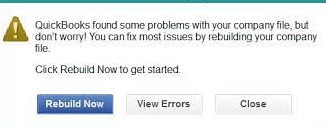

If the issue persists, you need to obtain professional data file repair assistance. You may wish to contact Intuit Data Services. Run the Rebuild Data utility after you return all templates to default. Use the procedure ( above) to Repair a Corrupted Template for all of your custom templates returning each to their default state. If the issue still is not resolved, Back-up your Company file. But if the default does not resolve your issue, you may need to repair the Template List ( below). If these steps resolved the issue, recreate the template using the copy.  Test the defaulted copy of the template. Click OK on the Basic Customization window. Click OK on the Additional Customization window.
Test the defaulted copy of the template. Click OK on the Basic Customization window. Click OK on the Additional Customization window. 
Please note this will delete all of the modifications in the template and reset it to the original default format.
At the bottom, center of the Advanced Customization window, click the button Default. Double click on the copy of the template. On Select Template Type, select the appropriate type of template and click OK. Right click on the damaged template, and then click the Templates down arrow at the bottom left. Click Advanced Customization at the bottom of the Basic Customization window. In the menu bar, select Lists, then choose Templates. Double click on the copy of the template – this opens the Basic Customization window. On Select Template Type, select the appropriate type of template and click OK. On the drop-down menu, click Duplicate. Right click on the damaged template, and then click the Templates down arrow at the bottom left. In the menu bar, select Lists, then choose Templates. If the issue still occurs with the test template, your template list may damaged. If the issue does not occur with the test template, your actual template may be damaged. Test to see if your issue still occurs with the test template. Open a form that can use the test template. Import the custom template from your desktop. Second, import the Custom Template into your Company file: Export the new template to your desktop. Test the template in the sample/test company to assure it works. Create a custom template similar to the template that's not working. So, let's look at the procedures to test for and repair corrupted templates:įirst, begin by creating a Custom Template within a QuickBooks sample company: In some cases, you can restore the template to it's default format and will no longer be corrupted.īut if it's the standard template that became corrupted, that's an entirely different matter that will require professional repairs. You sometimes can review each and every template from the template list (for that specific transaction type) and see if any prove to be the culprit. Such corruption can occur if QB shuts down or the connection to the QB Database Server is lost with a transaction open but no portion of it saved. When they were saved, the transaction template was valid, but at some point, something subsequently caused the template to become corrupted. Many times, transactions that will not open or cannot be deleted have a transaction template error. One of the most common is template damage. When this occurs, there can be several different types of data damage that could produce the defect. It seemed they couldn't even open these transactions without QuickBooks crashing. Recently, one of the forums I participated in had a member write in about some corrupted transactions.










